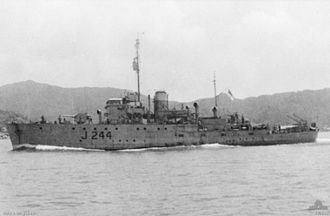HMAS Castlemaine (J244)
|
|
|
|---|---|

|
|
| period of service | |
| Builder: | Melbourne Harbor Trust , Williamstown (Victoria) |
| Keel laying: | February 17, 1941 |
| Launch: | August 7, 1941 |
| Commissioning: | June 17, 1942 |
| Fate: | Decommissioned on December 14, 1945 and used as a training hulk, since 1974 museum ship in Williamstown (Victoria) |
| General properties | |
| Ship type : | corvette |
| Displacement : | 650 ts standard 1025 ts maximum |
| Length: | 57.7 m |
| Width: | 9.1 m |
| Draft : | 2.6 m |
| Drive : | 2 Admirality 3-drum steam boilers 2 triple expansion steam engines 1750 WPS (1290 kW) on 2 screws |
| Speed : | 15 kn |
| Crew : | 80 |
| Armament: | 1 x 4 inches - gun 1 × 40 mm Bofors - Flak 3 x 20 mm Oerlikon-guns up to 40 water bombs |
The HMAS Castlemaine (J244) was a Bathurst-class corvette of the Royal Australian Navy named after the city of Castlemaine (state of Victoria ) during World War II . A total of 60 ships of this class were built during the war in Australia as part of the war emergency program as mine sweepers, 36 for the Royal Australian Navy, 20 for the British Admiralty but manned and used by the Royal Australian Navy, and four more for the Royal Indian Navy .
After her commissioning, the Castlemaine was used as an escort ship between Sydney and Melbourne until it collided with a ferry on August 11, 1942 in Sydney Harbor . After the repairs were completed, she was transferred to Townsville , from where she escorted convoys to Port Moresby . On October 5, 1942, the corvette finally arrived in Darwin and was used from there to support the fighting on Timor . Their job was to transport troops to Timor and evacuate the wounded and refugees to Australia.
On November 29, she set course for Betano together with the HMAS Armidale . Fresh Dutch troops were to be landed there on the night of November 30th to December 1st and 190 Dutch soldiers and 150 Portuguese civilians were to be evacuated. On the way, the two corvettes were attacked three times by Japanese aircraft without any significant damage. At the landing site, however, no contact could be made with troops on land, which is why the ships retreated to the open sea so that they would not be within sight of the coast at daybreak. In the course of the day, the two ships came across the patrol boat HMAS Kuru , which was on its way to Darwin with 70 refugees on board. The refugees were taken to the Castlemaine , which took them to Darwin, while Armidale and Kuru independently returned to Timor . At 3:15 p.m. on the afternoon of December 1, the Armidale was attacked and sunk by 13 Japanese aircraft.
Then the Castlemaine was used to escort convoys from Darwin to Thursday Island . On December 15 and 16, the freighter Period and James Cook , which were protected by it, were attacked three times from the air. Not least because of the corvette's defensive fire, the Japanese only scored one hit during the attacks during the period , which resulted in four deaths and six wounded. After all Allied troops had been withdrawn from Timor in the spring of 1943, the Castlemaine was still in use in northern Australian coastal waters until December 1943, mainly as an escort ship, but also for other tasks and some mine clearing operations. From December 1943 to August 1944 she was used again as an escort ship on the route between North Australia and New Guinea . This was followed by monitoring tasks on the Australian north coast until the end of the war through the Japanese surrender on August 15, 1945. The corvette was then sent to Hong Kong , where it took part in the surrender ceremony of the Japanese troops there on August 29 and was used as a mine sweeper in the following weeks has been.
In November 1945 the Castlemaine returned to Melbourne, where it was decommissioned on December 14th. From 1955 she was then used in the naval base Flinders Naval Depot (called HMAS Cerberus ) near Crib Point as a stationary training hull for machine personnel. In 1973 she was finally donated to the Maritime Trust of Australia and is now a museum ship at the historic Gem Pier in Williamstown (Victoria) near Melbourne. She is the last ship in her class still in existence.
Web links
Coordinates: 37 ° 51 ′ 39.9 ″ S , 144 ° 54 ′ 20.4 ″ E
